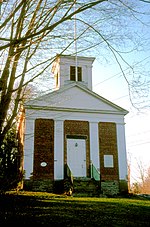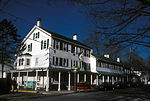First Baptist Church of Essex, Connecticut
Baptist churches in ConnecticutChurches in Middlesex County, ConnecticutConnecticut church stubsEssex, Connecticut

The First Baptist Church in Essex, Connecticut, built in 1846, is notable for being one of only three Egyptian revival churches known to have ever been built in the United States. The architect was Minard Lafever.The handsome, white clapboard building features a tripartite facade, the central section of which is a frustum that rises to support the cupola. The church's original steeple was destroyed after being struck by lightning in 1925.
Excerpt from the Wikipedia article First Baptist Church of Essex, Connecticut (License: CC BY-SA 3.0, Authors, Images).First Baptist Church of Essex, Connecticut
Prospect Street,
Geographical coordinates (GPS) Address Nearby Places Show on map
Geographical coordinates (GPS)
| Latitude | Longitude |
|---|---|
| N 41.355 ° | E -72.3923 ° |
Address
Prospect Street 12
06426
Connecticut, United States
Open on Google Maps









